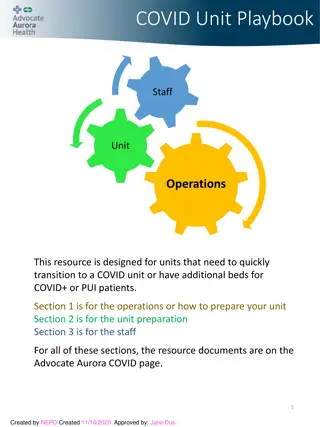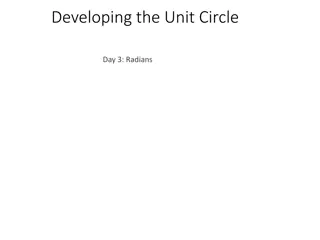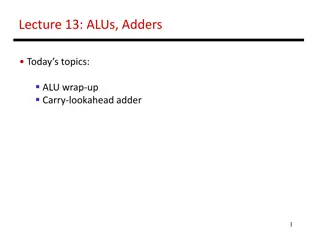Understanding Fluidization in Unit Operations
Fluidization is a process that occurs when a fluid passes upwards through a bed of particles, leading to a state where particles are lifted and the bed behaves fluid-like. This phenomenon has numerous benefits such as improved mass and heat transfer, enhanced reaction rates, and better temperature control. By analyzing pressure loss, particle behavior, and applications of fluidization, it becomes clear how this process plays a crucial role in various industries.
Download Presentation

Please find below an Image/Link to download the presentation.
The content on the website is provided AS IS for your information and personal use only. It may not be sold, licensed, or shared on other websites without obtaining consent from the author. Download presentation by click this link. If you encounter any issues during the download, it is possible that the publisher has removed the file from their server.
E N D
Presentation Transcript
When a fluid is passed upwards through a bed of particles the pressure loss in the fluid due to frictional resistance increases with increasing fluid flow. A point is reached when the upward drag force exerted by the fluid on the particles is equal to the apparent weight of particles in the bed. At this point the particles are lifted by the fluid, the separation of the particles increases, and the bed becomes fluidized. General Objectives:- Get benefit from dead zone. Improvements of Mass & Heat Transfer. Increasing rate of Reaction, and controlling Temperature due to continuous mixing
weight of particles Upthrust on particle = pressure drop Bed cross sectional area
For a bed of particles of density p, fluidized by a fluid of density f to form a bed of depth H and voidage in a vessel of cross-sectional area A:- 1 ( )( ) HA p f = ) 1 . 7 ( p A = 1 ( )( ) ) 2 . 7 ( p H g p f
A plot of fluid pressure loss across the bed versus superficial fluid velocity through the bed would have the appearance of Figure 7.1. Referring to Figure 7.1, the straight line region OA is the packed bed region. Here the solid particles do not move relative to one another and their separation is constant.
The pressure loss versus fluid velocity relationship in this region is described by the Carman Kozeny equation :-
A: Pressure drop = gravitational force. Particles beginto move B: Bed in loosest position with grains in contact. B-C: Grains separate and true fluidization begins C-D: Random travel of particles, particles begin to actsingly, no entrainment of particles batch fluidization D: Particles entrained in fluid continuous fluidization
Uses for fluidization: 1. Chemical reactors 2. Heat exchange 3. Drying 4. Coating 5. Solidification / granulation 6. Growth of particles 7. Adsorption / desorption 8. Others
Advantages of fluidization: 1. Liquid like behavior easy to control and automate 2. Rapid mixing, uniform temperature and concentrations. 3. Slow to respond to rapid temperature changes. 4. Useful for large and small operations. 5. Heat and mass transfer rates are high, requiring smaller surfaces. Disadvantages of fluidization: 1. Bubbling beds of fine particles are difficult to predict. 2. Rapid mixing of solids causes non-uniform residence times for continuous flow reactors. 3. Particle break-up. 4. Pipe and wall vessels erode due to particle collision. Behavior of fluidized beds: 1. Lighter objects float on top of the bed, i.e., objects less dense than the bulk density of the bed. 2. The surface stays horizontal even in tilted fluidized beds. 3. The solids can flow thru and opening in the vessel just likea liquid. 4. The beds have a static pressure head due to gravity,given by gh
Kinds of Fluidization:- 1)Incipient Fluidization:- It is occurs at minimum fluidization velocity umf. In order to determine umf , starting to increase velocity of fluid gradually with reducing p for each velocity. Then inverse the process by decreasing fluid velocity and recording p then plot log u against log p on log-log paper. Or plot log u against H. u p H u1 p1 H1 u2 p2 H2 u3 p 3 H 3 . . . . . .
2)Aggregate Fluidization:- If u>umf , bubbling fluidization. If u>>umf , sludge fluidization. Fluid and solid densities are greatly different, or particles are large, need higher velocities. Bubbles then brust at the surface spraying particles above the bed.
3) Particulate Fluidization:- Fluid and solid densities not too different, particles are small. Liquid instead of gas, so bed fluidized evenly with each particle moving individually through relatively uniform mean path. To distinguished between aggregative and particulate fluidization, use (Fr. No.):- 2 u u = = . . Fr No mf mf d g d g p p
4)Channel and Spout Fluidization:- At velocity near umf, particles have fine surface (smooth) and viscous (waxes). Gas passed through channel, this kind is in efficient. we could use plates in the bed to break on these channels?? 5)Transport Fluidization:- At higher velocity u>>>umf, for carrying solid materials, cement.
Evaluation of umf Mathematically:- Force balance Pressure force must equal gravity-buoyant force 1 ( = 1 . ). .( ) p l g s g Sub in Carman-Kozeny Equation:- 3 1 1 = 1 ( ). .( ) u l g mf 2 2 s g 5 l 1 S
At s=6/d for sphere 2 3 ( ) d g 1 s g = u mf 180 1 ( ) Bed Height and Porosity Volume of Fluidized Bed = LA 1 Fraction of volume which is solid = ( ) e LA 1 Total volume if the solids were all one piece =
Since the solids volume must be conserved, it follows that ( ) 1 1 1 = A L ( ( 2 1 L ( ) 1 L A 2 2 Or ) ) 1 L = 1 2 1 For large value of Reynolds number at incipient fluidization Ergun equation is preferred: ( ) 2 l 1 2 u u 1 P = + 150 c . 1 75 c 3 2 3 d d
where d is the diameter of the sphere with the same volume/surface area ratio as the particles. At incipient fluidization, the above equation becomes: ( ) 1 2 2 1 u u ( 1 )( ) mf mf 2 mf mf = + 150 . 1 75 g mf s 3 3 d d mf mf 3 d Multiplying both sides by , we get ( 1 ) 2 mf ( ) 2 d d 1 u u 3 gd . 1 75 mf mf mf = + 150 s 2 3 mf 3 mf
Defining Galileo number as ( Then the equation becomes: = ) d u s 3 gd mf= mf = R e and Ga 2 1 e 1 75 . mf mf mf + 2 150 Ga R e R e 3 mf 3 mf e e For a typical value of emf = 0.4, we get: mf mf = + 2 1406 27 3 . Ga R e R e We can put: mf mf + = 2 51 4 . 0 0366 . 0 R e R e Ga
R e Solving for , we get: mf 1 ( ) Ga = + 5 25 7 . 1 5 53 . 10 Rmf e for emf= 0.4. Similar way can be applied for other values of emf.
Correlation between Sphericity and emf The sphericity can be defined as / d = d s p ( ) , where = and / 1 3 6 = d V / A d 6 V / p p p p d here is the diameter specified for the particle as it is used in Ergun equation and dp is the diameter of sphere having the same volume. The relation between sphericity and emf was found experimentally and represented by two relations: 1 e 1 = 11 mf e 3 mf 2 s 1 1 = 14 e 3 mf s
Minimum fluidizing velocity in terms of terminal failing velocity The minimum fluidizing velocity, umf, may be expressed in terms of the free-falling velocity uo of the particles in the fluid. The relation is ( o Ga 33 . 2 e R = ) 13 3 . . 1 53 Ga . 0 . 0 018 016 The above equation applies when there is no wall effects, that is when d/dt is very small. Alternatively Fig. 6.4 can be used to find the ratio of minimum fluidizing velocity to the terminal velocity
Liquid Solid Fluidization In liquid solid fluidization the expansion of the bed is more regular from the minimum fluidization velocity to the terminal velocity. Liquid solid fluidization is similar to sedimentation system. The two systems are similar in that in the fluidized bed the particles undergo no net movement and are maintained in suspension by the upward flow of liquid, whereas in the sedimentation the particles move downwards and the is the liquid flow upward which is displaced by the settling particles. The bed expansion can be found by using u = = ( ) n c e 1 C n u i Where: uc is the empty tube fluidization velocity, ui is the corresponding velocity at infinite dilution, e is the voidage of the system, C is the volumetric fractional concentration of solids
And n is an index, its values are between 2.4 and 4.8 and can be found by the relation: . 0 27 4 . 2 8 . 4 n d = . 0 043 Ga 1 . 1 24 . 0 57 n d t The following equation for fluidization was presented to find the relation between ui and uo: 6 . 0 u d = . 1 1 15 i u d o t Alternatively, the index n can be found by using Fig. 6.5
Example: Spherical solid particles having a size of 0.12 mm and density of 13.6 kg of 1000 kg/m3 are to be fluidized using air at 2 atm and 25 0C. the porosity at minimum fluidizing condition is 0.42. If cross-sectional area of empty bed is 0.3 m2 and bed contains 300 kg of solid, calculate the minimum height of fluidized bed? Calculate p at minimum fluidizing condition? Calculate minimum fluidizing velocity knowing that viscosity of air is 1.845*10-5 pa.s? Solution:- Volume of solid= ms/ s =300/1000= 0.3 m3 L1= 0.3 m3/0.3 m2=1 m, if =0 1 l 1 1 . 0 42 mf = = = i . 1 742 l m mf 1 1 0 l l 1 mf mf
1 g p= s g l mf mf . . 2 * 29 P M wt 3 = = = . 2 374 / kg m g . 298 * 82 05 . R T ( 1000 ) . 1 = 724 1 ( . 0 pa 42 ) . 2 374 . 9 * 81 p 5 0978 . 0 = 10 * . 2 3 ( ) d g 1 s g 3 = = . 5 415 * 10 sec u m mf 180 1 ( ) If the velocity is three times umf find porosity?
Example2:- 3.6 kg of solid particles of density 2590 kg/m3 and mean size 748 mm form a packed bed of height 0.475m in a circular vessel of diameter 0.0757 m. Water of density 1000 kg/m3 and viscosity 0.001 Pa s is passed upwards through the bed. Calculate (a) the bed pressure drop at incipient fluidization (b) theminimum fluidization velocity (c) the mean bed voidage at a superficial liquid velocity of 1.0 cm/s (d) the bed height at this velocity and (e) the pressure drop across the bed at this velocity.
Example 1.15 kg of particles of particle density 2000 kg/m3 are fluidized in a vessel of cross sectional area 0.03m2 by a fluid of density 900 kg/m3. (a) What is the frictional pressure drop across the bed? (b) If the bed height is 0.6 m, what is the bed voidage? 2.A packed bed of solid particles of density 2500 kg/m3, occupies a depth of 1 m in a vessel of cross-sectional area 0.04m2. The mass of solids in the bed is 50 kg and the mean diameter of the particles is 1 mm. A liquid of density 800 kg/m2 and viscosity 0.002 Pa s flows upwards through the bed. (a) Calculate the voidage (volume fraction occupied by voids) of the bed. (b) Calculate the pressure drop across the bed when the volume flow rate of liquid is 1.44m3/h. (c) Calculate the pressure drop across, the bed when it becomes fluidized. [Answer: (a) 0.5; (b) 6560 Pa; (c) 8338 Pa.]
3.Obtain a relationship for the ratio of the terminal falling velocity of a particle to the minimum fluidizing velocity for a bed of similar particles. It may be assumed that Stokes Law and the Carman-Kozeny equation are applicable. What is the value of the ratio if the bed voidage at the minimum fluidizing velocity is 0.4? 4.A packed bed consisting of uniform spherical particles of diameter 3 mm and density4200 kg/m3, is fluidised by means of a liquid of viscosity 1 mNs/m2 and density1100 kg/m3. Using Ergun s equation for the pressure drop through a bed height l andvoidage e as a function of superficial velocity, calculate the minimum fluidising velocity in terms of the settling velocity of the particles in the bed. State clearly any assumptions made and indicate how closely the results might beconfirmed by an experiment.
Minimum fluidizing velocity in terms of terminal failing velocity The minimum fluidizing velocity, umf, may be expressed in terms of the free-falling velocity uo of the particles in the fluid. The relation is ( o Ga 33 . 2 e R = ) 13 3 . . 1 53 Ga . 0 . 0 018 016 The above equation applies when there is no wall effects, that is when d/dtis very small. Alternatively Fig. 6.4 can be used to find the ratio of minimum fluidizing velocity to the terminal velocity
Liquid Solid Fluidization In liquid solid fluidization the expansion of the bed is more regular from the minimum fluidization velocity to the terminal velocity. Liquid solid fluidization is similar to sedimentation system. The two systems are similar in that in the fluidized bed the particles undergo no net movement and are maintained in suspension by the upward flow of liquid, whereas in the sedimentation the particles move downwards and the is the liquid flow upward which is displaced by the settling particles. The bed expansion can be found by using
u ( ) n = = c e 1 C n u i Where: uc is the the empty tube fluidization velocity, ui is the corresponding velocity at infinite dilution, e is the voidage of the system, C is the volumetric fractional concentration of solids, and n is an index, its values are between 2.4 and 4.8 and can be found by the relation: . 0 27 4 . 2 8 . 4 n d = . 0 043 Ga 1 . 1 24 . 0 57 n d t
The following equation for fluidization was presented to find the relation between ui and uo: = 0 . 6 u d 1 1 . 15 i u d o t Alternatively, the index n can be found by using Fig. 6.5
Example: 3.6 kg of solid particles of density 2590 kg/m3 and mean size 748 mm form a packed bed of height 0.475m in a circular vessel of diameter 0.0757 m. Water of density 1000 kg/m3 and viscosity 0.001 Pa s is passed upwards through the bed. Calculate (a) the bed pressure drop at incipient fluidization (b) theminimum fluidization velocity (c) the mean bed voidage at a superficial liquid velocity of 1.0 cm/s (d) the bed height at this velocity and (e) the pressure drop across the bed at this velocity.
Solution: (a) To find the packed bed voidage, we use the following expression for the mass of particles in the bed: Mass of particles in the bed ( ) AL = = s M 1 e Mass of particles in the bed ( . 0 ) 2 0757 ( ) = = 3498 . 0 = 360 1 e 2590 . 0 475 e 4 To find pressure drop we use the following relation ( )( ) ( ) ( ) = = 3498 . 0 = P 1 e lg P 1 2590 1000 . 0 475 . 9 81 4817 Pa s
(b) Assuming that the voidage at the onset of fluidization is equal to the voidage of the packed bed, we use the Ergun equation to find minimum fluidization velocity: ( ) ( 1000 2590 1000 gd Ga 2 1 e 1 75 . mf mf mf = + 2 150 Ga R e R e 3 mf 3 mf e e ) ( ) 3 . 9 81 2 748 10 3 6 = = = 6527 s ( ) 1 10 3 1 3498 . 0 . 1 75 mf mf mf mf = + = + 6527 150 R e R e 6527 2278 6 . R e 40 88 . R e 2 2 ( . 0 ) ( . 0 ) 3 3 3498 3498 mf mf + = R e 55 . 73 R e 159 . 66 0 2 ( ) 2 159 55 73 . 55 73 . 4 66 . mf = = R e . 2 73 2
6 748 10 1000 u d u mf mf mf = = R e . 2 73 . 0 001 = = 0036 . 0 / . 0 36 / u m s cm s mf
1.15 kg of particles of particle density 2000 kg/m3 are fluidized in a vessel of crosssectionalarea 0.03m2 by a fluid of density 900 kg/m3. (a) What is the frictionalpressure drop across the bed? (b) If the bed height is 0.6 m, what is the bedvoidage? 2.A packed bed of solid particles of density 2500 kg/m3, occupies a depth of 1 m in a vessel of cross-sectional area 0.04m2. The mass of solids in the bed is 50 kg and the mean diameter of the particles is 1 mm. A liquid of density 800 kg/m2 and viscosity 0.002 Pa s flows upwards through the bed. (a) Calculate the voidage (volume fraction occupied by voids) of the bed. (b) Calculate the pressure drop across the bed when the volume flow rate of liquid is 1.44m3/h. (c) Calculate the pressure drop across, the bed when it becomes fluidized. [Answer: (a) 0.5; (b) 6560 Pa; (c) 8338 Pa.] 3.Obtain a relationship for the ratio of the terminal falling velocity of a particle to theminimum fluidising velocity for a bed of similar particles. It may be assumed that Stokes Law and the Carman-Kozeny equation are applicable. What is the value of the ratio ifthe bed voidage at the minimum fluidising velocity is 0.4?
4.A packed bed consisting of uniform spherical particles of diameter 3 mm and density4200 kg/m3, is fluidised by means of a liquid of viscosity 1 mNs/m2 and density1100 kg/m3. Using Ergun s equation for the pressure drop through a bed height l andvoidage e as a function of superficial velocity, calculate the minimum fluidising velocity in terms of the settling velocity of the particles in the bed. State clearly any assumptions made and indicate how closely the results might be confirmed by an experiment.
Calculate the minimum velocity at which spherical particles of density 1600 kg/m3 and of diameter 1.5 mm will be fluidized by water in a tube of diameter 10 mm on the assumption that the Carman- Kozeny equation is applicable. Discuss the uncertainties in this calculation. Repeat the calculation using the Ergun equation and explain the differences in the results obtained.























